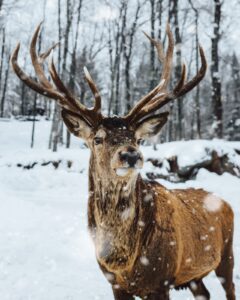
- Nov 16, 2020
- Agescan International
- Uncategorized
- 1 Comment
As the cold weather settles in and the snow covers the ground, the conditions for hunters can become tricky to navigate. The preparation for winter hunting is noticeably different — often calling for a change in clothing and shotgun cartridges — different from the ones hunters typically rely on in the summer months. Though the landscape looks different and the animals that roam may have shifted, winter hunting can be just as rewarding as the experience is known to be when the weather is warm and inviting.
The success of winter-based hunting comes down to one word: preparation. Agescan International is on the forefront of manufacturing the best hunting equipment, and here we break down the five key ways to improve your winter hunting experience.
Location Scouting
Hunting grounds in North America often vary in the size of game available to hunt, especially when the temperatures drop. The further north you’re able to travel, the more opportunities are likely to be presented. Research is key if you’re unfamiliar with the area you plan on travelling to. To ensure the area offers winter hunting and to clarify any questions you might have, check in with the local wildlife management authorities.
Investing in Quality Equipment
The equipment you choose to take out with you on your hunt will have a major impact on the success of your hunting experience. If your goal is precise pellet penetration, it’s in your best interest to put your money towards gear that is designed to maximize its impact and last for years to come. Your equipment shouldn’t be susceptible to cold temperatures. As the weather fluctuates and temperatures drop, having non-toxic shotshells should be a priority — as shotshell ammunition decreases in acceleration and the atmosphere becomes thicker. The thicker the atmosphere, the more resistance hunters face.
The industry is noticing these changing patterns and the equipment is beginning to reflect the needs of present-day hunters and evolving ecosystems. More and more hunters are steering away from lead-based ammunition and turning to tungsten shotshells.
Many manufacturers are leading the way in environmentally-conscious components, ammunition, and equipment. Tungsten is a key reason why today’s hunters are able to keep up the hobby in the colder months — its wind-resistant properties are crucial to hunting in winter months.
Visit agescantungsten.com to see the science behind how Tungsten alloy balls are designed to withstand corrosion, inflated temperatures, abrasion, and extensive wear. As the hunting landscape evolves and modern hunters are changing their equipment expectations, tungsten super shot shells are meeting their needs while simultaneously prioritizing the well-being of our evolving ecosystems.
Learning to Track
Tracking is a useful skill for hunters at every level, but it requires time and practice to fully hone your skills. The strategies you employ can impact the entire experience. If your goal is to track large buck but you lack the experience, start small and learn to track rabbits or squirrels. A smaller game will allow you to fine-tune your skills before you move on to larger targets. Practice makes perfect, especially if you’re looking to improve your winter hunting experience. Understanding the three S’s — scout, stealth, scent — will be the foundation for an effective hunting season, no matter the temperature.
Dressing the Part
Selecting the right gear is the most important piece of the puzzle — without it, you won’t last long in the cold temperatures. There’s a balancing act between staying warm and ensuring you’re able to move freely throughout your chosen landscape.
Layering is going to be your best friend if you’re hunting in the winter months. Most importantly, you’ll want to invest in quality, breathable fabrics with moisture-wicking properties like polypropylene — this is especially important for your base and insulating layers. Your outer layer is the next piece of the puzzle. Choosing wool or down will keep your body warm under colder temperatures and if you’ve invested in quality over price, should last you for multiple seasons. Lastly, investing in warm gloves, wool hats, and neck warmers will allow you to utilize your equipment correctly and protect your skin.
Don’t Neglect Nutrition
Being exposed to the elements can test your body in several ways — ensuring you have adequate food and water supply is imperative to keep your nutrition where it should be, and you can continue to perfect your hunting techniques. In colder temperatures, we are likely unaware of our hydration levels the way we are when we’re exposed to scorching temperatures. Making a conscious effort to pack and eat protein-based snacks and vitamin-rich beverages will allow your body to adapt to changing temperatures and maximize your experience.
Winter hunting in North America is unlike any other. With changing temperatures and a unique variety of game to hunt, investing in quality equipment and understanding your surroundings in-depth will keep you safe — ensuring your winter hunting experience is sustainable and a season to remember.


Pingback: Which Shotgun Cartridges Will Work Best for You? | Agescan International